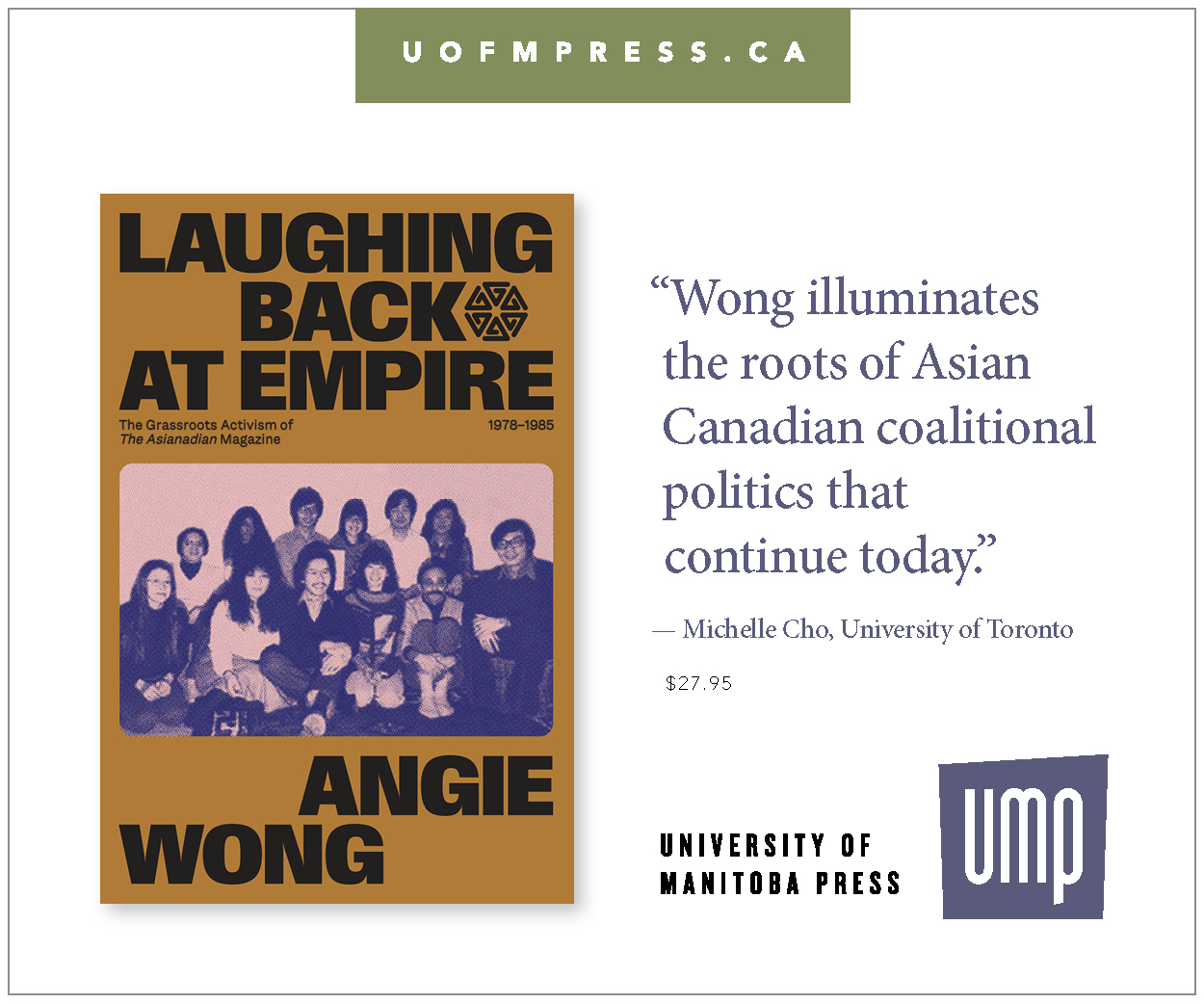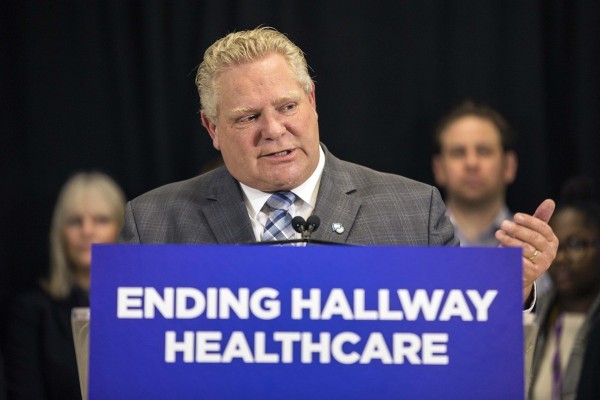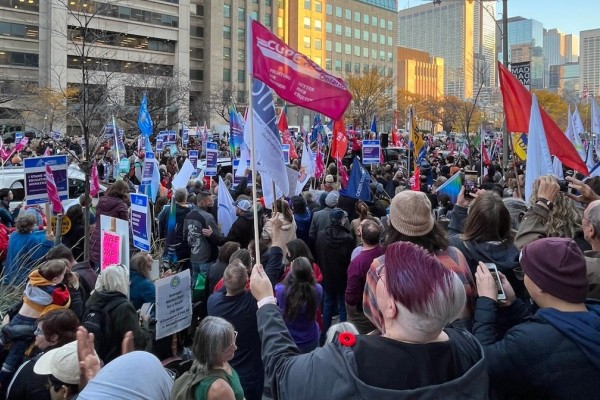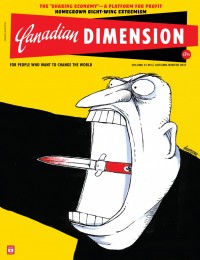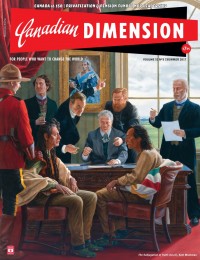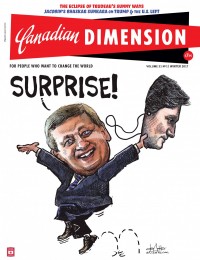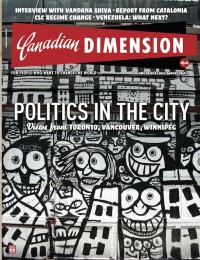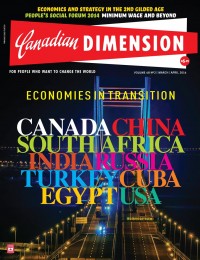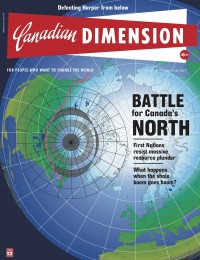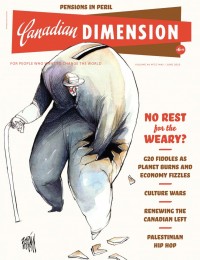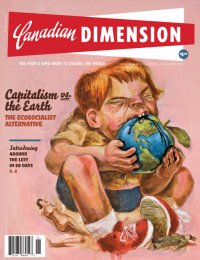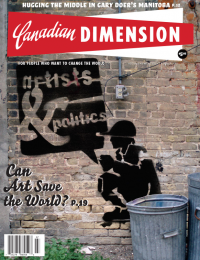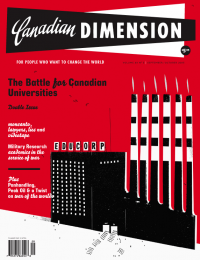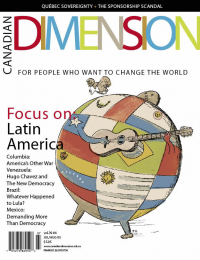School wars in Ontario: McKinsey consultants, eLearning, and wage cuts
Thompson: Every recent Ontario government has worked to attack the education system and those who work in and rely on it
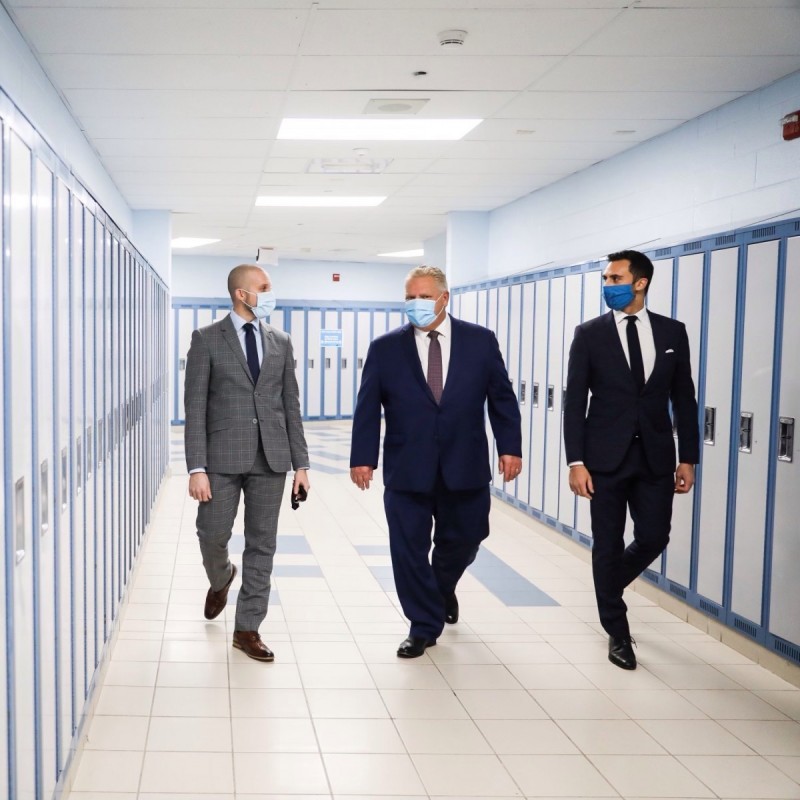
Ontario Premier Doug Ford, middle, and Education Minister Stephen Lecce, right, walk the hallway at a Toronto-area middle school, November 2020. Photo from Twitter.
Since 2018, Doug Ford’s Progressive Conservatives have attacked education funding and devised repeated schemes to privatize parts of the school system.
If reelected, new attacks will likely be on the agenda—because profit demands it.
Doug Ford’s ‘Action Plan’
In September 2018, ahead of imminent education cuts, the Ford government quietly released a line-by-line “spending review”—A Modernization Action Plan for Ontario—conducted by the multinational accounting firm Ernst & Young (EY).
Previously, Ford had neglected to issue a platform, promising instead merely to find “efficiencies” across the public sector to cut corporate taxes. Aside from fighting the carbon tax, sex education and the minimum wage, his plan offered few details.
This EY review, based on Treasury Board data, was far less ambiguous.
“This is an opportunity,” the EY review claimed. The 50-page report suggested the Ford government centralize collective bargaining across the broader public sector—“including transfer payment recipients”—to “control” compensation and implement a “high productivity,” “agile workforce dynamic.”
It suggested replacing, wherever possible, full-time, permanent staff with more-precarious hires and dumping new user fees onto Ontarians.
Finally, it advised the Ford government to find ways to privatize parts of the school system, “imposing competitive pressure on public sector providers” by “expanding market activity and discipline.”
While the language in these suggestions may, broadly speaking, involve more syllables than many of Ford’s pronouncements, they share a common theme: workers and youth need to learn to live with less.
‘Competitive pressure’
Soon after the review, the government unveiled its plan to fire 10,000 teachers and increase class sizes. Then, in June 2019, the government tabled its legislated wage cut for teachers and the rest of the public sector, to further shrink the compensation package.
Elsewhere, in Education Minister Stephen Lecce’s own words, the government sought to replace “union members” with non-union personnel.
The government also sought to replace human teachers with mandatory online learning, modeled on similar experiments in Alabama and Arkansas, with higher class size caps. A leaked memo further revealed plans to sell online learning content “at a profit.”
Further, Ford himself also expressed an openness to scrapping full-day kindergarten, remarking: “we’ll sit down and you’ll hear from us in the future.”
In the face of mass protests involving hundreds of thousands of students, teachers and community members, Ford was intransigent. He refused to “roll over” and “give the unions what they want.” In early 2020, after he was repeatedly asked if he would use strikebreaking legislation, he threatened, “There’s only so long my patience can last with the head of the unions… So stay tuned.”
These changes took direct aim at students. Ford said that pushing kids into online learning classes, with higher class size caps, would save hundreds of millions of dollars and “prepare our young people for the jobs of the future.” His then Education Minister, Lisa Thompson, was more blunt, saying it would help students develop “resiliency” and “coping skills,” in “stressful situations.”
COVID-19 erosions
Since March 2020, after many of the unions settled, it appears that the Ford government has quietly accomplished many of its earlier ambitions.
Into September 2021 cash-strapped schools were reportedly forced to “collapse” classes together—pushing up to 30 and even 40 kids in COVID-19 vector classrooms.
Despite complaining of a teacher shortage, the government has also reportedly offered fewer full-time teaching contracts than it did before the pandemic. In some cases, the government has also empowered school boards to contract out educational work to any adult who passes a criminal record check.
Instead of protecting students, the Ford government was busy contracting McKinsey & Company to find ways to leverage Ontario’s public schools in accordance with “private sector supply chains.”
Elsewhere, the government expanded its eLearning program, with an additional directive for TVO, a key supplier, to “commercialize” its educational content. The government has also approved a litany of private online schools as an alternative to the publicly-delivered system.
Meanwhile, at various times, Ford has revealed plans to massively cut school funds and issue “redundancy notices” to thousands of education workers. And, on the whole, adjusting for enrollment and inflation, Ontario’s education spending is now $800 lower per student than in 2018.
While the government hasn’t managed to keep students safe or maintain school funding, it has pushed for standardized testing, conducted by the Education Quality and Accountability Office, to plough ahead.
A spokesperson for Ford’s education minister pledged to use the test—widely-regarded as a way to “discipline” teachers and students and force schools to compete for funding—to “measure progress and make data-driven decisions to lift student performance.”
Cartoon by Steve Nease/Toronto Sun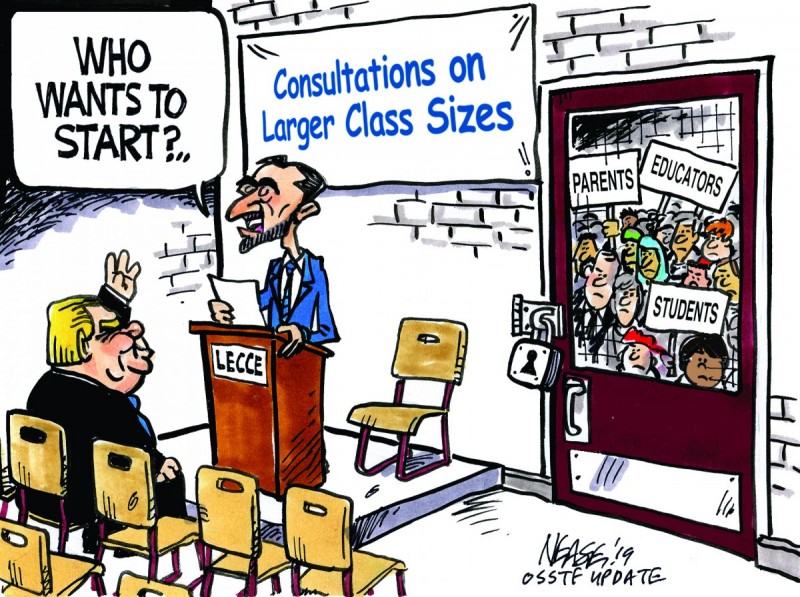
The cuts to come
According to the Financial Accountability Office, the government’s current spending projections point to a $12.3 billion shortfall by the end of the decade. The report notes that this will come at the direct expense of classroom staffing, supplies and education quality.
But the future may be more ominous still.
According to a different FAO report, with a net debt of $195.1 billion, the Ontario government has “little fiscal flexibility in the event of a future economic downturn.” Already, Moody’s and the Ontario Financing Authority have appealed for cuts.
While the 2022 budget includes $1.2 billion in cuts by 2024, that budget has not been passed. Ford’s past finance minister has not promised to leave the budget unchanged if the PCs are re-elected. And, already hundreds of education workers have been told they may lose their jobs, as key transfers from the province to school boards are set to expire—just after the election.
If cuts are demanded by the province’s bondholders, one should expect Ford to oblige.
But this problem goes beyond the premier.
The truth is that every recent Ontario government has worked to attack the education system and those who work in and rely on it.
The Liberal Party’s current proposal to build 200 new schools, for example, is less impressive when one considers that the Liberals planned to close 333 schools when they last governed. Current leader Steven Del Duca, moreover, firmly backed the Liberals’ Bill 115, which froze teachers’ pay, eliminated their banked sick days and cut their retirement benefits—calling it “tough medicine.”
“Ontario public sector settlements are now below the average of those in the private sector, municipal sector and the federal public sector,” Del Duca celebrated in the legislature. “Pension expense forecasts are down, in part as a result of successful efforts to contain public sector wage growth.”
The Liberals further allowed schools to deteriorate and set up the current, market-oriented eLearning service. Likewise, while they were in power, they just as eagerly courted McKinsey consultants and carried out cuts and closures.
In 2007, McKinsey called Ontario’s school system one of the “most improved” in the world when it came to “robust performance management systems” with “incentives that are relevant to the sector and job functions within it.”
In 2012, as the Liberal budget prepared over $17 billion in cuts, the government consulted with TD economist Don Drummond to explore ending full day kindergarten, raising class sizes, limiting special education and charging tuition for students who require an extra year to graduate. That same report reiterated that the key purpose of education is “future prosperity.”
The subsequent cuts in the provincial budget were noted alongside pledges to use the school system to ensure “Ontario’s workforce is among the most skilled in the world and better positioned to compete globally.”
‘Economic necessity’
Unlike other social programs, ending full public support for education is not in the interest of the wealthy and powerful. But cutting teachers’ pay, limiting public programming to the basics of employer needs and privatizing classes wherever possible certainly is.
As R.D Gidney notes, the growth of universal education, insofar as it exists, is a fairly recent development in Ontario. Prior to the 1960s, even senior high school was an elite domain, intended “to select and prepare a minority of students for the universities and professions.”
But the growth of programming and the expansion of curriculums has always been restricted to the needs of the market. Through the 1960s, the expansion of Ontario’s network under John Robarts endeavored to develop “human capital” in accordance with the needs of employers. Accordingly, it was also punctuated by purges of left-wing teachers.
Andy Hanson notes likewise in his history of Ontario’s elementary teachers unions, Class Action, that with the economic slowdown of the 1970s and the ascent of right, politicians saw “The use of education dollars to create an additional level of policing.”
According to professor Alison Taylor, as unemployment rose and funds were comparatively scarce, the school system was reoriented towards “discipline,” job training and “belt-tightening.” In 1988, the premier’s council advised that schools be re-oriented further towards “government industry partnerships,” while acknowledging that, in the face of the recession and “restructuring” the potential need for “sacrifices by all.”
A subsequent Ministry of Education-funded 1994 report, Restructuring: New Realities, New Beginnings, more explicitly demanded education spending “savings” in the service of “economic necessity.”
Since then, Taylor writes, the system has also been dissipated to resolve “the perceived ‘mismatch’ between the aspirations of students and their ultimate destinations.”
Simply put, each expansion and retrenchment has occurred in tension with governments that are ever-eager to find cuts and employers who have no interest in a working class that is educated or expects to be educated beyond its day-to-day job functions.
Many of Ford’s policies today are recycled versions of the attacks of the past and designed to achieve the same ends—albeit magnified by his usual crassness.
The cuts demanded today are, to that end, a part of the program of broader attacks on workers elsewhere. They are, in some ways, about preparing youth for the “jobs of the future.”
Mitchell Thompson is a writer, editor and occasional radio producer based in Toronto.

.png)

